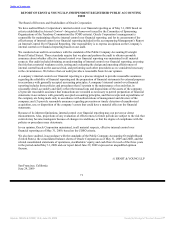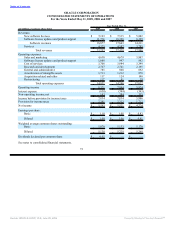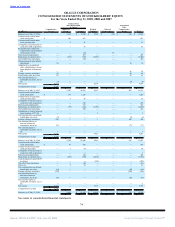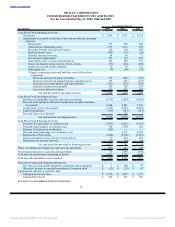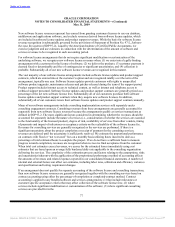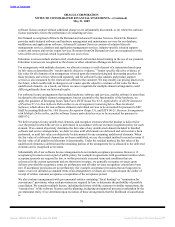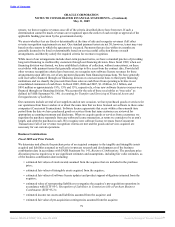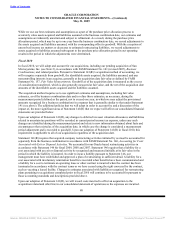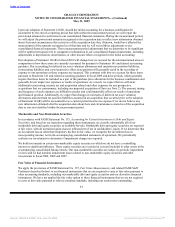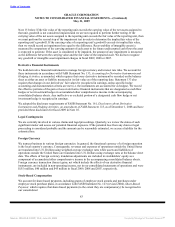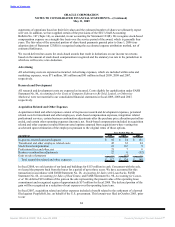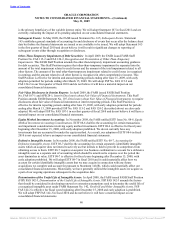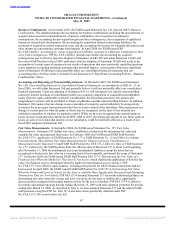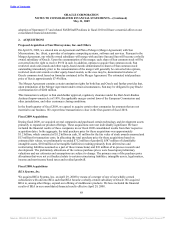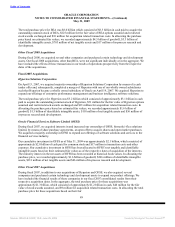Oracle 2008 Annual Report Download - page 87
Download and view the complete annual report
Please find page 87 of the 2008 Oracle annual report below. You can navigate through the pages in the report by either clicking on the pages listed below, or by using the keyword search tool below to find specific information within the annual report.
Table of Contents
ORACLE CORPORATION
NOTES TO CONSOLIDATED FINANCIAL STATEMENTS—(Continued)
May 31, 2009
remote, we then recognize revenues once all of the criteria described above have been met. If such a
determination cannot be made, revenues are recognized upon the earlier of cash receipt or approval of the
applicable funding provision by the governmental entity.
We assess whether fees are fixed or determinable at the time of sale and recognize revenues if all other
revenue recognition requirements are met. Our standard payment terms are net 30; however, terms may vary
based on the country in which the agreement is executed. Payments that are due within six months are
generally deemed to be fixed or determinable based on our successful collection history on such
arrangements, and thereby satisfy the required criteria for revenue recognition.
While most of our arrangements include short-term payment terms, we have a standard practice of providing
long-term financing to creditworthy customers through our financing division. Since fiscal 1989, when our
financing division was formed, we have established a history of collection, without concessions, on these
receivables with payment terms that generally extend up to five years from the contract date. Provided all
other revenue recognition criteria have been met, we recognize new software license revenues for these
arrangements upon delivery, net of any payment discounts from financing transactions. We have generally
sold receivables financed through our financing division on a non-recourse basis to third party financing
institutions and we classify the proceeds from these sales as cash flows from operating activities in our
consolidated statements of cash flows. In fiscal 2009, 2008 and 2007, $1.4 billion, $1.1 billion, and
$891 million or approximately 19%, 15% and 15%, respectively, of our new software license revenues were
financed through our financing division. We account for the sale of these receivables as “true sales” as
defined in FASB Statement No. 140, Accounting for Transfers and Servicing of Financial Assets and
Extinguishments of Liabilities.
Our customers include several of our suppliers and on rare occasion, we have purchased goods or services for
our operations from these vendors at or about the same time that we have licensed our software to these same
companies (Concurrent Transactions). Software license agreements that occur within a three-month time
period from the date we have purchased goods or services from that same customer are reviewed for
appropriate accounting treatment and disclosure. When we acquire goods or services from a customer, we
negotiate the purchase separately from any software license transaction, at terms we consider to be at arm’s
length, and settle the purchase in cash. We recognize new software license revenues from Concurrent
Transactions if all of our revenue recognition criteria are met and the goods and services acquired are
necessary for our current operations.
Business Combinations
Fiscal 2009 and Prior Periods
We determine and allocate the purchase price of an acquired company to the tangible and intangible assets
acquired and liabilities assumed as well as to in-process research and development as of the business
combination date in accordance with FASB Statement No. 141, Business Combinations. The purchase price
allocation process requires us to use significant estimates and assumptions, including fair value estimates, as
of the business combination date including:
• estimated fair values of stock awards assumed from the acquiree that are included in the purchase
price;
• estimated fair values of intangible assets acquired from the acquiree;
• estimated fair values of software license updates and product support obligations assumed from the
acquiree;
• estimated value of restructuring liabilities to reorganize the acquiree’s pre-acquisition operations in
accordance with EITF 95-3, Recognition of Liabilities in Connection with a Purchase Business
Combination (EITF 95-3);
• estimated income tax assets and liabilities assumed from the acquiree; and
• estimated fair value of pre-acquisition contingencies assumed from the acquiree.
79
Source: ORACLE CORP, 10-K, June 29, 2009 Powered by Morningstar® Document Research℠




